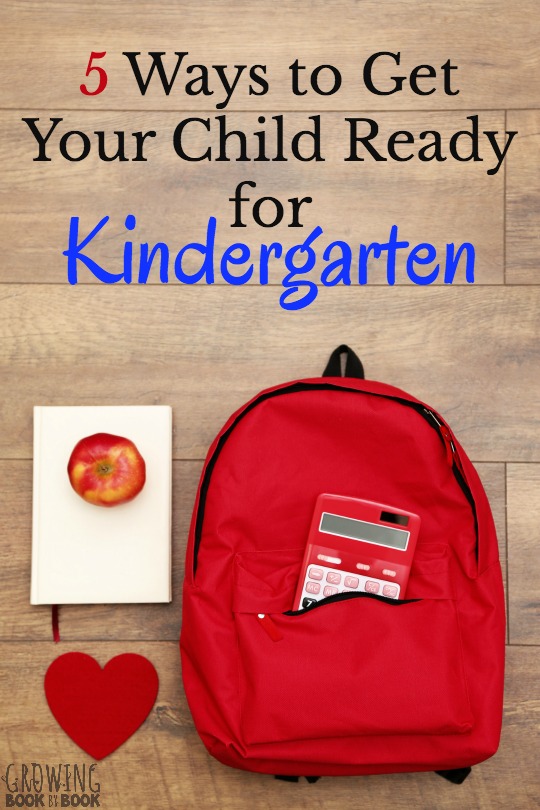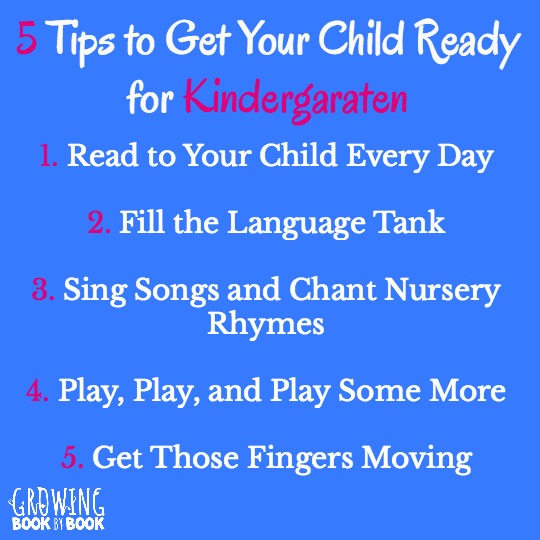I want my child to get ready for kindergarten. When should my child learn to read? My child knows their alphabet, now what? If you are a parent of a preschool age child, these are probably just a few of the many things that have run through your head. Surveying the literacy landscape for growing readers can be a daunting task.
Today I want to share with you five things you can be doing to help your child develop a strong foundation for future reading development.

5 Tips for Preparing Your Child for Kindergarten
Full Disclosure: This post contains affiliate links.
#1 Read Every Day to Your Child
It sounds so simple. But, it is the single most important thing we can do to help young children grasp language and develop a love of reading.
Develop a well-loved library that your child has access to each and every day. We have books in every room of the house. Yep, you’ll even find reading material in the bathroom. Bookshelves with backs to keep books from falling through, baskets of books sprinkled throughout the house, and books strewn on the coffee table are just a few ideas for making books accessible.
Enjoy a wide variety of books. Bring books into your house that will help kids develop imagination, learn about history and others, think, and laugh. Find books on topics that your child is passionate about and books that will broaden his horizon.
Set up reading rituals to make sure reading is part of your family culture each and every day.
SEE MORE: 150+ Book Lists for Kids and Book Lists for Kids by Age
#2 Fill That Language Tank
Children need to hear lots and lots of language in order to talk, read, and write. Look for little ways numerous times a day to talk WITH your child.
Play games with your child that will help him listen to individual sounds and rhymes. These are just two phonological awareness skills that help kids grasp the language system. We love to play these types of games when traveling in the car. One of our favorites is I Spy. I start by saying, “I Spy something in the car that begins with /m/. The kids then guess a word that begins with /m/. In this case, the word is a mirror.
Talk about the books you are reading together. Say to your child, “Tell Daddy about the book we read today.” Or ask, “What do you think the author wanted us to learn from this book?”
Don’t be afraid to use big words. There is no need to dumb down language when we are talking with kids. If your child doesn’t know a word you used, he’ll ask, and then you can have a quick lesson about the word. For example, my son and I were drawing with sidewalk chalk on the driveway. I said, “I’m going to extend this line for the runway.” He asked me, “What’s extend mean?” I responded, “If I extend something it means to increase or make it longer. If I extend this line, then our runway will be longer for a plane to take off.” If your child can say those long dinosaur names, he can handle words like extend, hollow, and feeble.
SEE MORE: Phonological Awareness Activities
#3 Sing a Song and Chant a Nursery Rhyme
Repetition is vital for helping kids grasp language skills. Singing songs and chanting nursery rhymes are two powerful tools for building those phonological awareness skills we talked about earlier.
Memorizing rhymes and poems also stretches those learning muscles. Try picking one a week to learn with your child. At the end of the year, you will both be able to recite over 50 rhymes or poems.
Dancing and moving while you sing will help your child make even more connections in their little brains. Many dances encourage kids to cross their midline which will help with future writing.
SEE MORE: Songs to Build Literacy Skills
#4 Play, Play, and Play Some More
Oh, the power of play! Maria Montessori said, “Play is the work of the child.” Our preschooler’s day should be filled lots of free play and guided play.
Free play is that self-directed time. It’s building with Lego, blocks, or our favorite, Magna Tiles. It’s raiding the closet for blankets and pillows to build a fort. It’s that jumbo-sized obstacle course the kids set up to run the length of the backyard. Kids are free to use their imaginations and create. As a caregiver, we can play along too. My favorite question to ask during free play is, “Tell me what you are working on. OR Tell me about your creation.”
Guided play is those hands-on activities that we play with our kids. This may be a giant sized rhyming memory game in the backyard, runaway letter with letter magnets, or a beginning sound ice melt. It’s a great time to build fine motor skills, alphabet recognition, and phonological awareness.
Both of my kids learned the letters of the alphabet through playing. They played with magnetic letters, ABC puzzles, and hands-on games. No need for flashcard drills or worksheets!
Turn off the tv, and encourage kids to play. If your child is attending a preschool, make sure there are ample opportunities for free and guided play.
SEE MORE: Playful Preschool Activities
#5 Get Those Fingers Moving
Before we can expect kids to write letters with the correct formation, a lot needs to happen. Writing is a complex task that requires lots of hand strength, eye-hand coordination, tracking, and more. Kids need lots of opportunities to work with their hands and build upper body strength.
Create a writing area in your home. My kids call it their “office.” It’s full of blank paper, blank books, crayons (these are our favorite for helping with a tripod grasp), markers, pens, pencils, and scissors. It’s a place that my kids gravitate to daily. Some days my oldest son is “writing” the next Elephant & Piggie book since Mo Willems isn’t writing them anymore. Or, my youngest son may be drawing a policeman.
Give your preschooler plenty of opportunities to use child scissors. Let him cut paper, straws, foam sheets, or cooked spaghetti.
Provide sensory experiences for kids to work their fingers and “draw”. Try shaving cream on the table, play dough, or salt trays. Kids can practice drawing lines, zig zags and circles. If your child is ready, he can begin to draw letters too.
SEE MORE: The Write Start

As an educator, we love to see kids entering kindergarten who have a love for learning, a love of books, and an active imagination. Knowing their alphabet and some letter sounds is also a plus. Using scissors to cut. Being comfortable holding writing utensils and knowing they make marks and those marks convey meaning. Having a strong foundation in phonological awareness is also essential. Showing an understanding of concepts of print (the way a book opens, the difference between a picture and words) is also essential and comes with having been read to a lot. Showcasing a good oral vocabulary and storytelling skills will round out a ready for kindergarten student.
So, take a deep breath. Read to your child every day. Try some of the other tips above each week. If you do that, your child will be on the road to reading. In fact, I’ve made it super easy for you to weave this all into your daily routine. Check out my Book Based Activity Calendars!
P.S. Have you signed up for our FREE newsletter? Each week you get lots of literacy goodies delivered to your inbox. Take a second and sign-up HERE.

Lady Lilith says
Fairytales! We love telling a good story about princesses and fairies with a good moral lesson to them.
Jodie Rodriguez says
Oh yes!